If you are a doubles player, then you know how important serve strategy is to win a match. Over the years, as data and analytics have started to play a bigger role in tennis, a term that is coming up more and more is serve + 1.
What is serve + 1? How does it impact our serve strategy in doubles? What can the net player do to help the server hold?
Below, I’m going to answer all these questions, and by the end of this lesson, you will be a better server in doubles.
What is Serve + 1 in Tennis?
Serve + 1 refers to the 3rd shot of the rally during a point. It is the first shot after the serve for the player or doubles team that serves.
In a rally, you have the serve, the return, then the serve + 1, then return + 1 and so on.
In doubles, the server or the server’s partner, usually at the net, can hit the serve + 1. Below you’re going to learn how to create an ideal serve strategy and why the serve + 1 is so important in doubles.
Skyrocket your serve strategy in doubles with this FREE 5-day course >>>
The Goal of Serve Strategy in Doubles
Serve strategy in doubles is different than singles.
The reason is simple. You have a partner at the net who will not let the returner hit a weak return.
In singles you can slice a slow ball high over the net back at the server, but not in doubles. That net player will attack it easily.
With that in mind, the goal of the serving team in doubles is always to set up the server’s partner at the net. Ideally, your partner should hit the serve + 1 when you are serving.
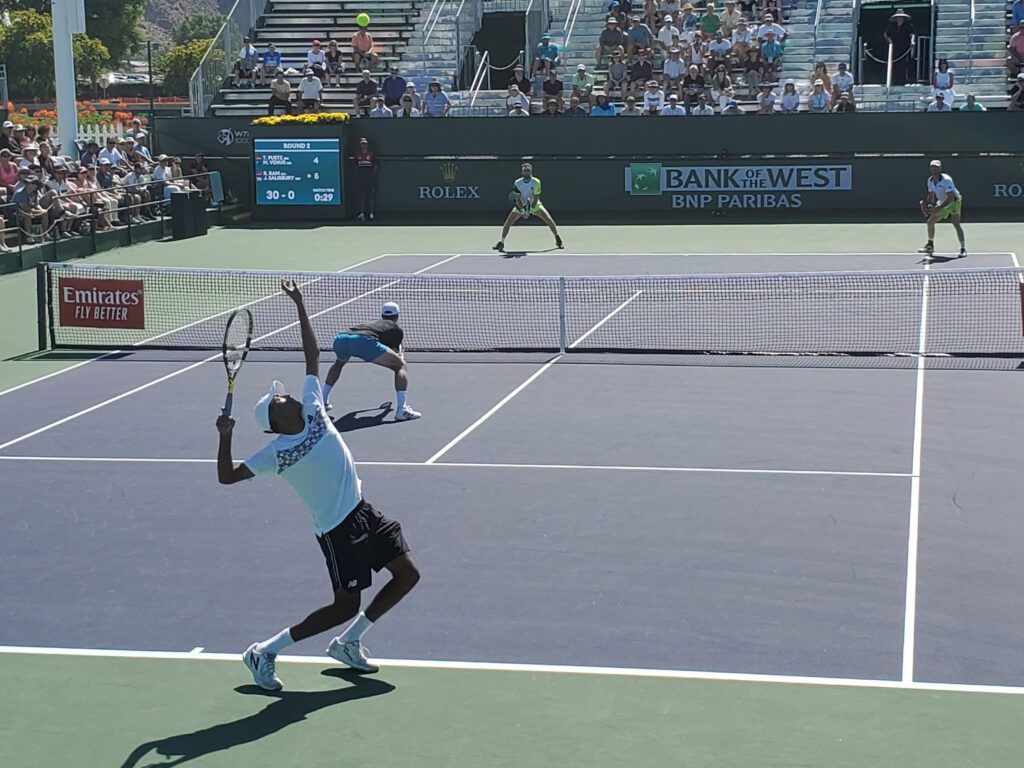
5 Tips to Set Up Your Doubles Partner When Serving
There are a lot of factors to consider when coming up with a serve strategy in doubles.
If the goal is to set up our partner at the net, what is the best plan?
- Should we hit our best serve as much as possible, regardless of location?
- Should we hit to the returners weakness more, even if it’s not our strongest serve?
- Should we spin it in to make more 1st serves?
Here are 6 tips to set up your partner for the serve + 1. You should prioritize in the order below.
#1 Make a High Percentage of 1st Serves
This is the most important part of serve strategy for doubles players.
I can’t tell you how many doubles players I’ve beaten who have a huge serve, but try to hit the ball 187 MPH. They want to hit aces 💪, which does not align with our goal of setting up the net player.
What happens?
They make 50% or less of their 1st serves and struggle to win their service games. There’s no better way to make the returner comfortable, and take your partner at the net out of play than missing 1st serves.
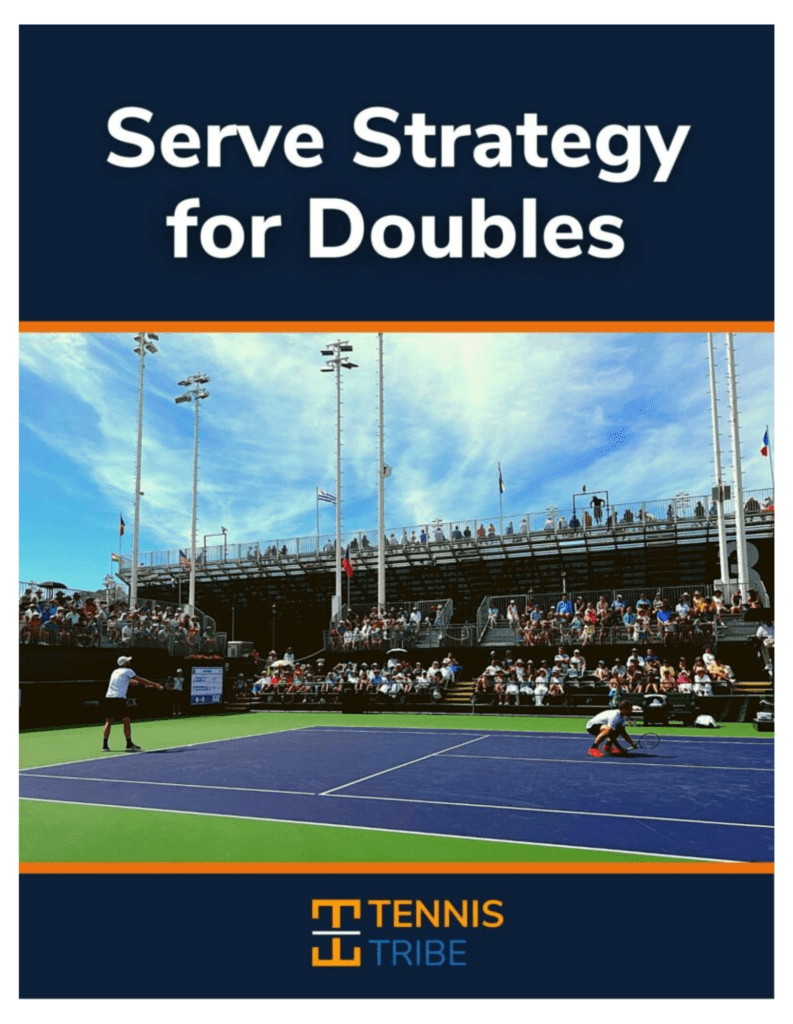
This 55-page Ebook includes EVERYTHING you need to know
Serve Tactics Guaranteed to Make Holding Serve Easy
Learn to hide your weaknesses, force return errors, and create game plans with your doubles partner to hold serve more often.
By taking 5-10 MPH off their 1st serve, they would increase their percentage, set up their partner more, hold far more easily, and beat me!
That said, if you sacrifice too much power, then the returner will have a field day. The ideal first serve percentage in doubles is around 70%.
You see this when you watch tennis on TV. Good doubles players will usually spin serves in to increase their percentage, while singles players hit flat serves more often, going for the ace or return error.
#2 Find the Opponent’s Weakness
It is more important to target the opponent’s weakness than it is to hit your strength.
99% of tennis players don’t understand this, even I didn’t until recently. Making your opponent uncomfortable is the easiest way to set up your partner at the net.
So, if the opponent has a weak backhand return, go 70% to 80% to their backhand.
When finding their weakness, you do have to consider your strength too.
For example, if they have a weak backhand return, but I simply can’t make a serve down the T on the deuce side, then it doesn’t matter.
But if you’re equally comfortable with both serve locations, it to their weakness.
#3 Use the Angles of the Tennis Court
If all else is equal, serving down the T is better than serving out wide in doubles.
If the opponent seems to have the same comfort level on the forehand and backhand return, and you’re just as comfortable serving to either side, hit 70% up the T.
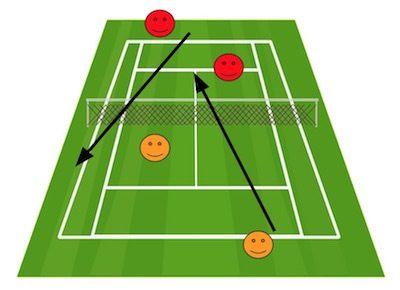
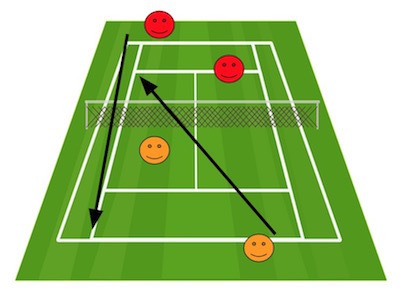
Going wide opens up the down-the-line return, which takes your net player out of position.
However, serving down the T lets your net player be more aggressive. They can pinch or poach without worrying as much about the alley because the angle for the returner to hit down the line closes dramatically.
#4 Play to Your Partner’s Strengths
Remember, we want your doubles partner at the net to hit the serve + 1. So, their strengths are more important than yours.
If they like their forehand volley, then find a way to let them be aggressive on the deuce side (for right-handed players).
On the Ad side, try different formations to put them in a position to hit the serve + 1.
#5 Focus On The Server’s Strengths Last
Although this is last on the list, that doesn’t mean it’s not important.
Remember rule 1 above. You want to make around 70% of 1st serves. Depending on your level, this might mean hitting your strongest serve regardless of the other factors.
That said, this should be the last factor to consider when developing your serve strategy. You generally do not want to sacrifice any of the first 4 factors just to hit your strongest serve.
This is also true of the serve + 1. Whether you like to serve and volley or stay back, if your partner does not hit the serve + 1, then you will.
Try to get a forehand volley or groundstroke if you can, but again, prioritize your partner’s strengths and the opponent’s weaknesses first. Those will play bigger factors in winning than your comfort level on the 3rd shot of the rally.
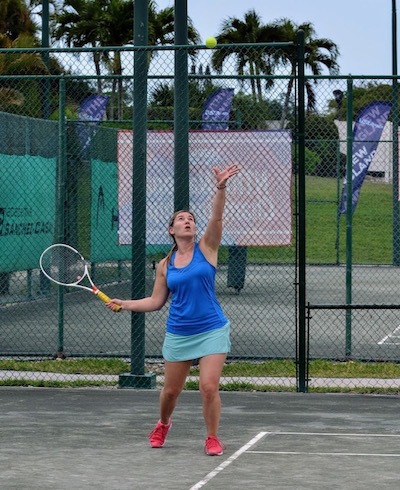
Bonus Tip #1 – Use Different Serve Formations
Different serve formations will help you create more errors from the returner, and make them uncomfortable.
Bonus Tip #2 – Use Variety on Your Serves
A lot of tennis players ask me “how much should I change where I’m serving?”
The answer, of course… it depends.
If the opponent simply cannot make a backhand return, then hit it there 100% of the time.
If however, they are relatively equal on both sides, then more variety will be important in not allowing them to get into a rhythm. Change up your pace, spin, and location to force return errors.
I usually find an opponent’s weakness and serve it there around 70% of the time. Then I’ll mix in the exact opposite serve in terms of pace, spin, and location, at big points in the match to force return errors.
Communicating with Your Doubles Partner on the Serve
You and your partner need to be on the same page. This means you both need to know.
- Where the server is serving.
- What the net player is doing – pinch, poach, or fake.
- If the server is going to serve & volley, or stay back.
If you know all of this information, you’ll be able to position yourself properly based on what the opponent does, and where you know your partner will be.
For example, if you know your partner is going to serve and volley, then the opponent opens their racquet face to lob, you better start running back to cover it.
MOST POPULAR COURSE!
25 Winning Doubles Tactics
Guaranteed to help you play smarter & win more matches.
- Over 50 video doubles lessons
- 60+ ATP & WTA points analyzed
- Nearly 3 hours of strategy content
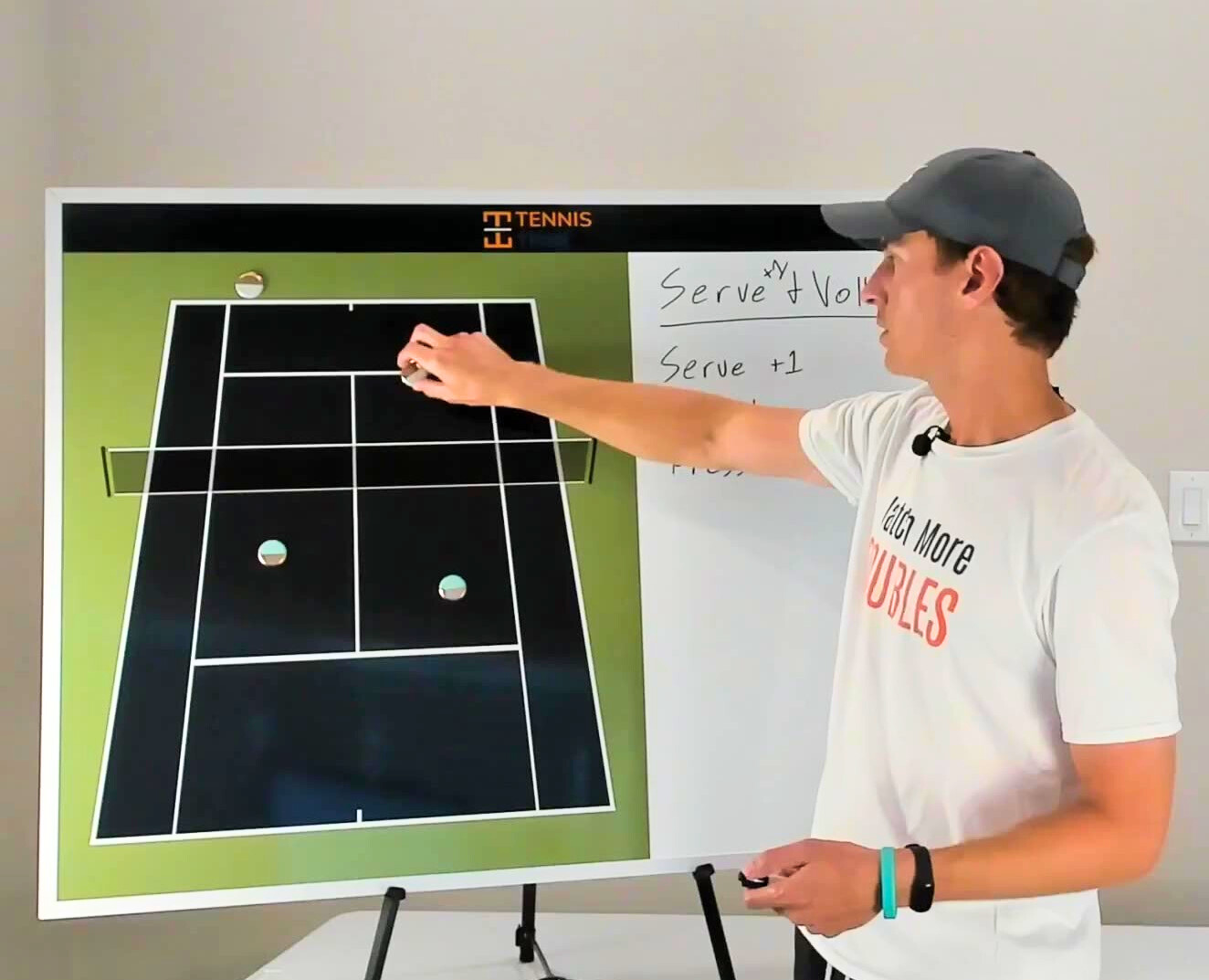
Will Boucek – ATP & WTA Doubles Strategy Analyst.
The Server’s Partner Must Read the Opponents
I’ve argued in the past that the most important player on the doubles court is usually the server’s partner.
This player needs to communicate and make sure they are on the same page as their partner as discussed above.
More crucially, they have to read the returner. It’s the net player’s job to see what’s happening on the other side of the net.
If the returner looks jammed or stretching wide for a shot, that’s your queue to be more aggressive. Pinch more, or poach to hit serve + 1 winners. You’ll also force them into errors as they try the difficult, low percentage shots down the line.
The Net Player Should Develop the Serve Strategy
The server’s partner should also help develop the serve strategy throughout the match.
The server’s responsibility is to focus on hitting their spots.
The net player needs to be reading the opponents and game planning at the net.
If you see a returner looking uncomfortable with a slow kick serve, tell your partner to keep hitting it! You are the lead strategist on the doubles court for the serving team, so it’s important that you pay attention to the opponents.
Doubles Serve Strategy Summary
Remember, the serving team’s goal is to set up the net player for the serve + 1. You can do that by prioritizing these on-court factors.
- #1 High 1st serve percentage, around 70%.
- #2 Serve to the opponent’s weakness.
- #3 Use the angles of the court.
- #4 Emphasize the net player’s strengths.
- #5 Use the server’s strengths.
- Bonus Tip: Include variety to throw the returner off.
The net player is the general on the doubles court for the serve team. They are responsible for calling the serves and movement. They should also be paying attention to the opponents’ strengths and weaknesses to improve the strategy over the course of the tennis match.
Do you have a favorite play or serve strategy in doubles? I’d love to hear it, so comment below!
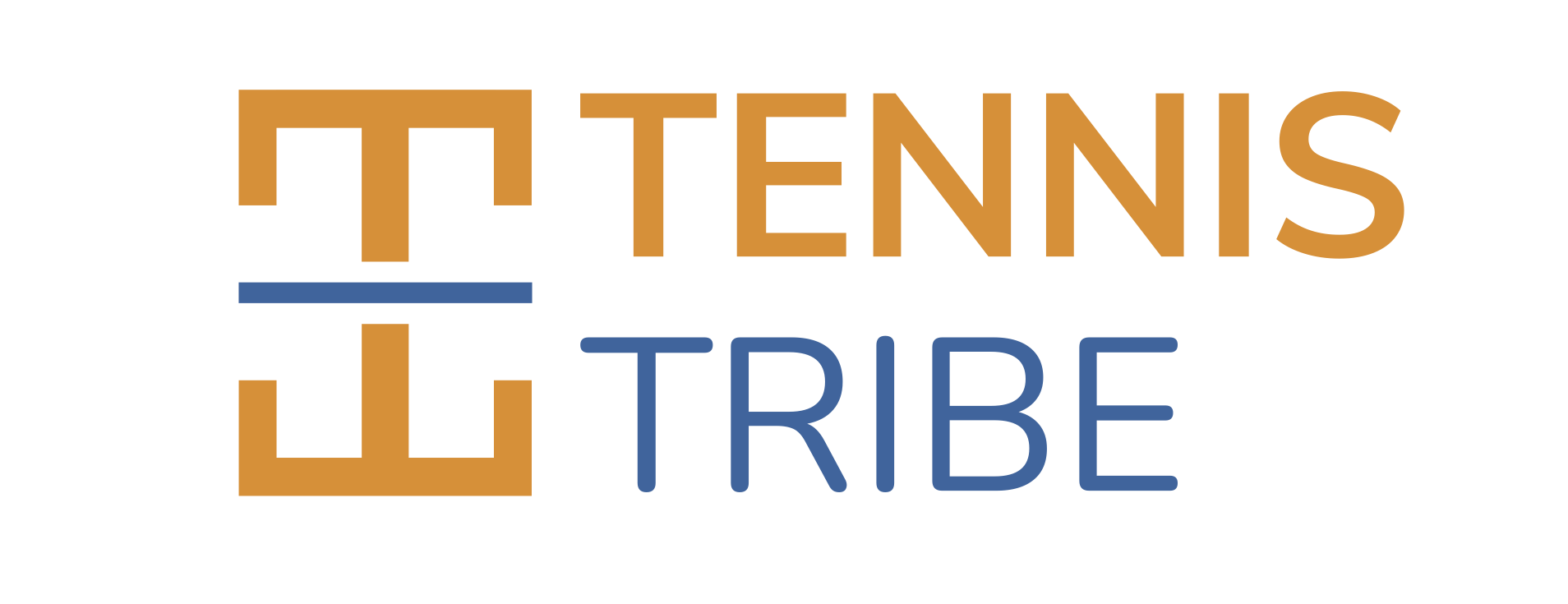
When your opponent is serving really high speed, its better to request your partner to stay back on baseline while you return first serve.
& For crucial points Tandem is the best option especially when you are serving on 30 – 40..
Always setup the point in doubles